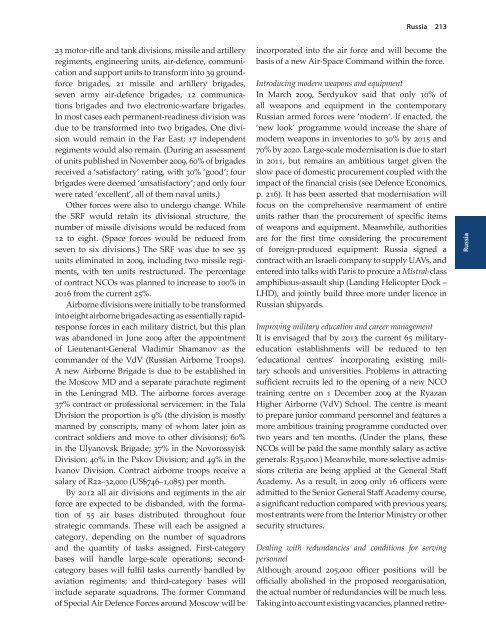You also want an ePaper? Increase the reach of your titles
YUMPU automatically turns print PDFs into web optimized ePapers that Google loves.
23 motor-rifle and tank divisions, missile and artillery<br />
regiments, engineering units, air-defence, communication<br />
and support units to transform into 39 groundforce<br />
brigades, 21 missile and artillery brigades,<br />
seven army air-defence brigades, 12 communications<br />
brigades and two electronic-warfare brigades.<br />
In most cases each permanent-readiness division was<br />
due to be transformed into two brigades. One division<br />
would remain in the Far East; 17 independent<br />
regiments would also remain. (During an assessment<br />
of units published in November 2009, 60% of brigades<br />
received a ‘satisfactory’ rating, with 30% ‘good’; four<br />
brigades were deemed ‘unsatisfactory’; and only four<br />
were rated ‘excellent’, all of them naval units.)<br />
Other forces were also to undergo change. While<br />
the SRF would retain its divisional structure, the<br />
number of missile divisions would be reduced from<br />
12 to eight. (Space forces would be reduced from<br />
seven to six divisions.) The SRF was due to see 35<br />
units eliminated in 2009, including two missile regiments,<br />
with ten units restructured. The percentage<br />
of contract NCOs was planned to increase to 100% in<br />
2016 from the current 25%.<br />
Airborne divisions were initially to be transformed<br />
into eight airborne brigades acting as essentially rapidresponse<br />
forces in each military district, but this plan<br />
was abandoned in June 2009 after the appointment<br />
of Lieutenant-General Vladimir Shamanov as the<br />
commander of the VdV (Russian Airborne Troops).<br />
A new Airborne Brigade is due to be established in<br />
the Moscow MD and a separate parachute regiment<br />
in the Leningrad MD. The airborne forces average<br />
37% contract or professional servicemen: in the Tula<br />
Division the proportion is 9% (the division is mostly<br />
manned by conscripts, many of whom later join as<br />
contract soldiers and move to other divisions); 60%<br />
in the Ulyanovsk Brigade; 37% in the Novorossyisk<br />
Division; 40% in the Pskov Division; and 49% in the<br />
Ivanov Division. Contract airborne troops receive a<br />
salary of R22–32,000 (US$746–1,085) per month.<br />
By 2012 all air divisions and regiments in the air<br />
force are expected to be disbanded, with the formation<br />
of 55 air bases distributed throughout four<br />
strategic commands. These will each be assigned a<br />
category, depending on the number of squadrons<br />
and the quantity of tasks assigned. First-category<br />
bases will handle large-scale operations; second-<br />
category bases will fulfil tasks currently handled by<br />
aviation regiments; and third-category bases will<br />
include separate squadrons. The former Command<br />
of Special Air Defence Forces around Moscow will be<br />
Russia<br />
213<br />
incorporated into the air force and will become the<br />
basis of a new Air-Space Command within the force.<br />
Introducing modern weapons and equipment<br />
In March 2009, Serdyukov said that only 10% of<br />
all weapons and equipment in the contemporary<br />
Russian armed forces were ‘modern’. If enacted, the<br />
‘new look’ programme would increase the share of<br />
modern weapons in inventories to 30% by 2015 and<br />
70% by 2020. Large-scale modernisation is due to start<br />
in 2011, but remains an ambitious target given the<br />
slow pace of domestic procurement coupled with the<br />
impact of the financial crisis (see Defence Economics,<br />
p. 216). It has been asserted that modernisation will<br />
focus on the comprehensive rearmament of entire<br />
units rather than the procurement of specific items<br />
of weapons and equipment. Meanwhile, authorities<br />
are for the first time considering the procurement<br />
of foreign-produced equipment: Russia signed a<br />
contract with an Israeli company to supply UAVs, and<br />
entered into talks with Paris to procure a Mistral-class<br />
amphibious-assault ship (Landing Helicopter Dock –<br />
LHD), and jointly build three more under licence in<br />
Russian shipyards.<br />
Improving military education and career management<br />
It is envisaged that by 2013 the current 65 militaryeducation<br />
establishments will be reduced to ten<br />
‘educational centres’ incorporating existing military<br />
schools and universities. Problems in attracting<br />
sufficient recruits led to the opening of a new NCO<br />
training centre on 1 December 2009 at the Ryazan<br />
Higher Airborne (VdV) School. The centre is meant<br />
to prepare junior command personnel and features a<br />
more ambitious training programme conducted over<br />
two years and ten months. (Under the plans, these<br />
NCOs will be paid the same monthly salary as active<br />
generals: R35,000.) Meanwhile, more selective admissions<br />
criteria are being applied at the General Staff<br />
Academy. As a result, in 2009 only 16 officers were<br />
admitted to the Senior General Staff Academy course,<br />
a significant reduction compared with previous years;<br />
most entrants were from the Interior Ministry or other<br />
security structures.<br />
Dealing with redundancies and conditions for serving<br />
personnel<br />
Although around 205,000 officer positions will be<br />
officially abolished in the proposed reorganisation,<br />
the actual number of redundancies will be much less.<br />
Taking into account existing vacancies, planned retire-<br />
Russia


